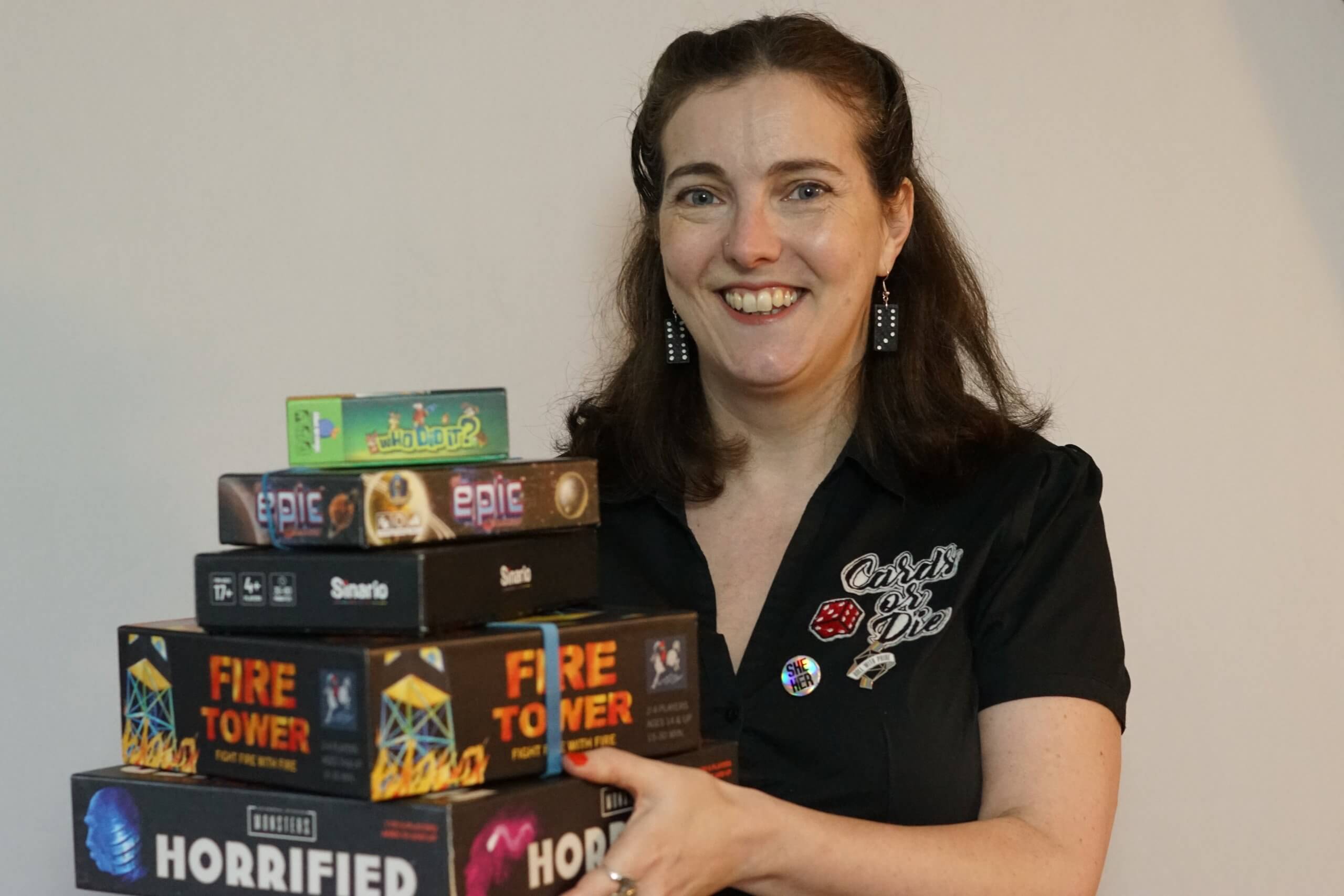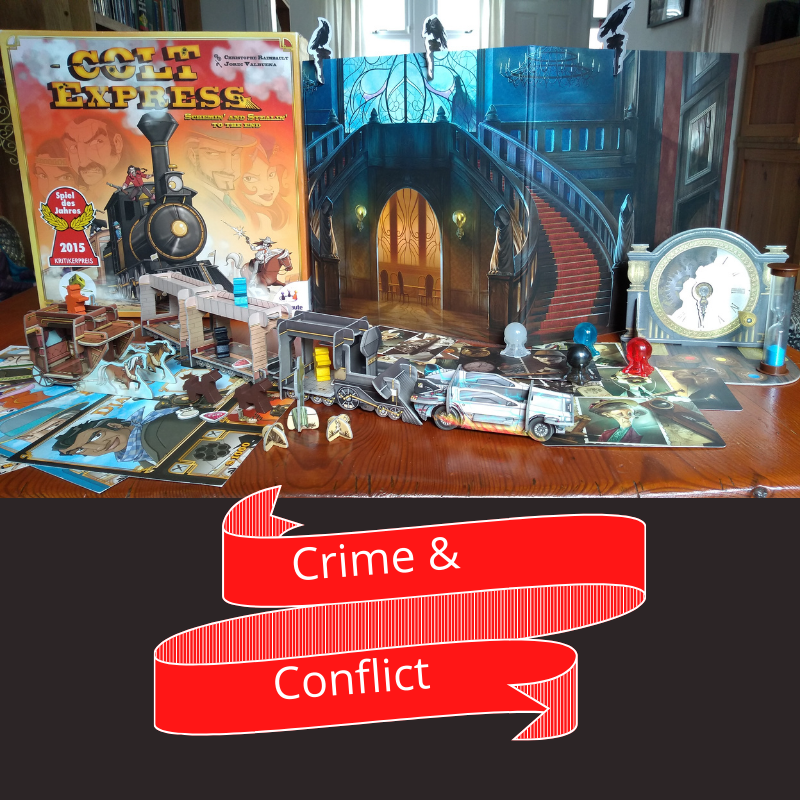
The novels chosen for the Crime & Conflict section are:
American Tabloid – James Ellroy
American War – Omar El Akkad
Ice Candy Man – Bapsi Sidhwa
Rebecca – Daphne du Maurier
Regeneration – Pat Barker
The Children of Men – P.D. James
The Hound of the Baskervilles – Arthur Conan Doyle
The Quiet American – Graham Greene
The Reluctant Fundamentalist – Mohsin Hamid
The Talented Mr Ripley – Patricia Highsmith
In this week’s workshop we looked at Crime themed games and also at the mechanics of programming, asymmetry and the use of silence in board games. You do not need to attend these sessions to enter the Games Jam and you can find out more about how to enter and how to be in with a chance of winning cash prizes here.
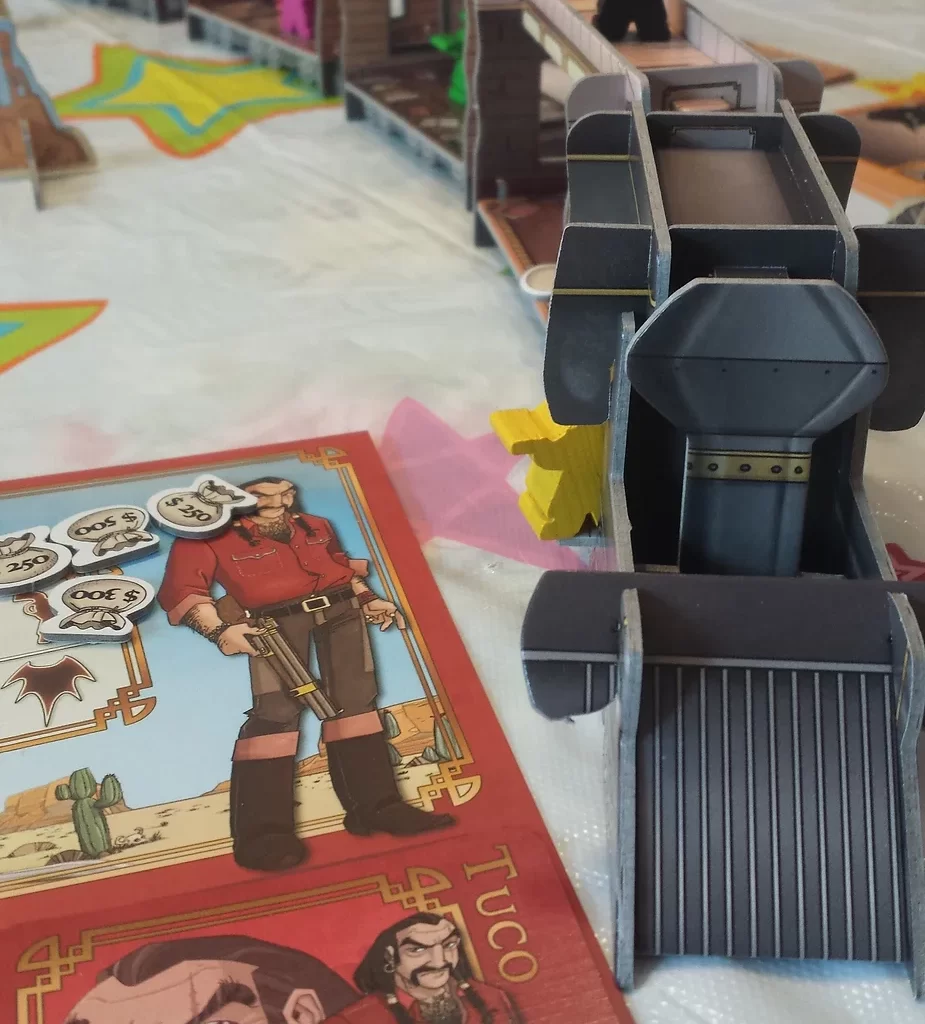
Colt Express
In Colt Express you are taking on the role of a wild west gunslinger who has boarded a train to steal as much loot as possible (including a daring steal from the Marshall himself!), punching and shooting the other thieves to end up with the most rich stuff. You can also earn a sharp shooter cash prize.
The game uses a cardboard train which players move from carriage to carriage and along the roof of. I also have a stagecoach expansion with horses, whiskey and yet more loot. As well as the DeLorean expansion from Back to The Future, which I absolutely love – it enables time travel of course.
Each round players take turns to select their actions and place them in a pile. Some actions are played in a tunnel so they are hidden (placed face down), sometimes two actions happen in quick succession. At the end of the round some events are triggered which may benefit or damage your characters.
Actions are chosen from each players deck of cards. So, the game also uses a deck wrecking mechanic because if you are shot you receive a bullet card that goes into your deck. If, at the start of the round where you plan to play 4 actions, 3 of the cards you draw to form your hand are bullet cards this blows a massive hole in your plans! You can pick up extra cards instead of having a turn but that means you are still missing out on one action. You need to not get shot. Easier said than done when everyone is gunning for you.
You need to watch out for the Marshall. One of your actions can be to move the Marshall. You need to get them away from the valuable case in order to steal it but get caught in the same carriage as the Marshall and they’ll shoot you with no hesitation leaving you injured and up on the roof!
If you end the round as the only player in the DeLorean then the other players must close their eyes while you climb beneath one of the carriages and remain hidden there until all players have chosen their actions for the round. Just before the story is relayed you leap into the carriage and wreak havoc with everyone’s carefully planned card selection!
The actions are all inter-reliant. For instance if I want to shoot someone, they need to be in another carriage whereas if I want to punch someone they have to be in the carriage with me. If I play these cards and those conditions are not true then my bullet goes wide and I swing my punch into fresh air.
The programming mechanic means that we each play all our turns for the round in order – placing our cards in a pile. Then, someone is nominated story teller and the fun begins. The story teller now flips the deck (so that the first card placed is on the top now) and tells us the story of the round. Guns are fired, people are punched, loot is dropped and grabbed. Sometimes our carefully planned actions work out perfectly, other times the person you were going to shoot has ducked out of your reach.
A programming mechanic is where players plan all of their actions in advance, they make decisions and lock in their choices. Then once everyone is planned the actions play out. It is clever because it involves a lot of planning and working out. You need to really keep a close eye on what other people are doing or what you predict they will do and try to plan accordingly.
As with many other games each character has a special abilities on their card – Cheyenne can steal in the same action as punching someone for instance while ghost can play a card secretly. The characters and character art is unfortunately very disappointing as it is far from representative and instead uses tropes we have long since tired of. There isn’t much more to say on this – honestly I feel tired even typing these words. Please just do better.
It’s worth having a think here about expansions too. Some designers have their expansions planned out when they are making the base game and others don’t. It’s entirely up to you but as you are basing your game on a novel there may be room to record some preliminary ideas about possible expansions as you are working on this game. I’m an advocate of recording all ideas in some format no matter how sketchy or vague they seem. You can always look back on them later and decide if they have any real mileage.
The cardboard train and the extra components – the addition of cacti and skulls make this a really visually appealing and tactile game. People always comment on it when it’s out on a table and moving the characters along the train does make the game more fun, it makes the story more immersive and takes you back to simpler times when you played with characters and created stories for them. For me it was the Fisher price village! Colt Express lives on our favourites shelf and I’m always sorely tempted to treat myself to a nice play may for it to sit on.
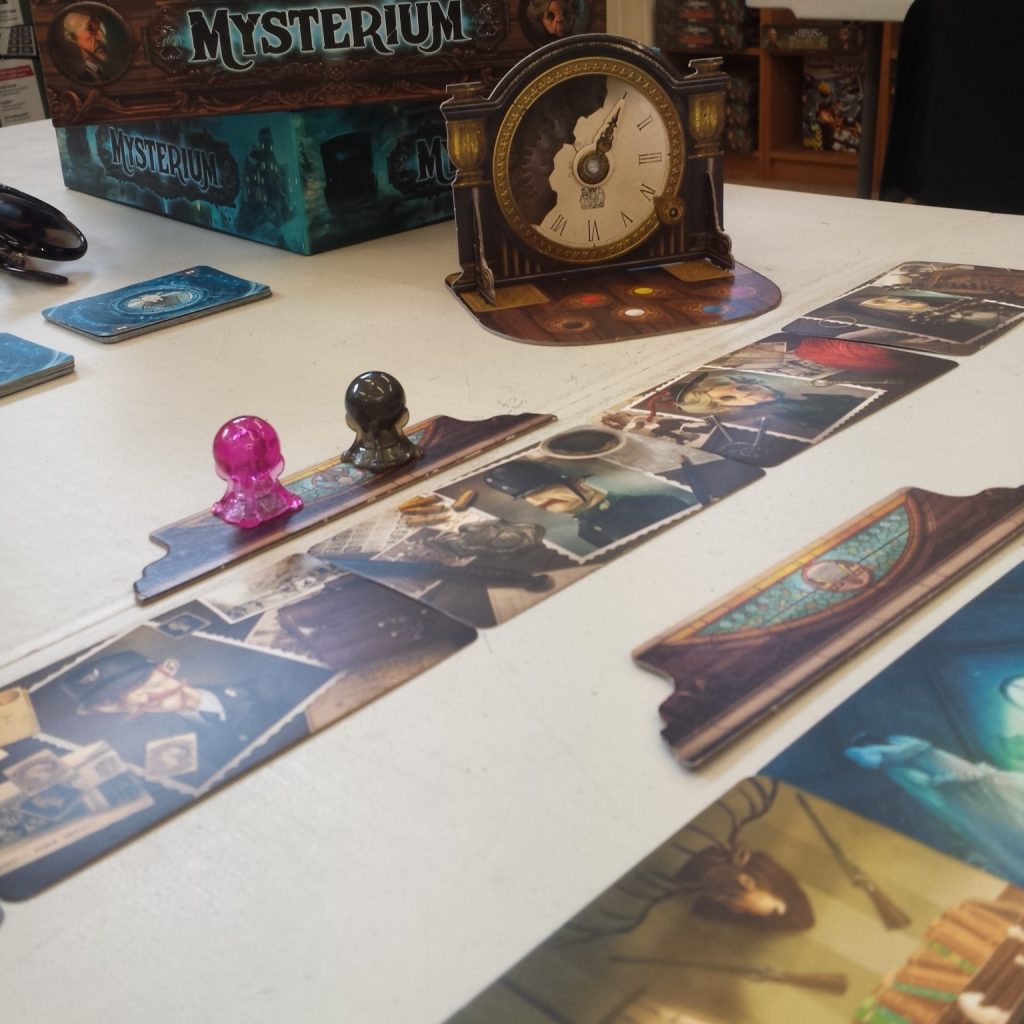
Mysterium
In Mysterium a house is being haunted by a restless spirit. In order to help the spirit rest you need to work together to solve the mystery of their murder. One player will play the role of the ghost – communicating in visions (using the cards) to the other players who are visiting psychics. We have touched on the use of silence in games in a couple of the other workshops. The ghost (of course) operates in silence. The psychics use the visions to deduce who the murderer was, where the murder took place and what weapon was used. Lots of people recognise Cluedo in this game which is no bad thing.
It’s an unusual game because the ghost and the psychics are playing very differently and completing different actions even though they share a common goal. It also adds to the replayability of the game as you can play different characters as well as the game relying on different interpretations of the images.
Often at events that I run, people start by playing or at least picking up and chatting about retro games that they are familiar with and have fond memories of. If your aim is to explore a novel or encourage people to go away and read a specific novel then using a familiar game as a starting point may help you to reach more people and make your game more accessible. It all depends on your audience. In the workbook I have asked you to think carefully about and identify audience before you even begin designing. Audience is key.
Each turn the ghost gives each psychic a vision – the ghost has been traumatised understandably and in the first phase of the game we are narrowing down the suspects with each psychic receiving their own suspect, location, and weapon. In the second part of the game the ghost presents a shared vision pointing towards the culprit, weapon, and location. The psychics then vote secretly on which they think the answer is. If the majority get it right then the game is won and the spirit is set free. Get it wrong and the spirit is bound to the house, destined to repeat this exhausting exercise until some more skilled psychics can solve the mystery!
The game is best played with 4 or more players as you can then use clairvoyancy tokens – these allow you to demonstrate your amazing skill by predicting which of the psychics are right. If your predictions are accurate then you have higher levels of clairvoyancy enabling you to see more of the final shared vision.
It doesn’t always feel like a co-operative game because of the guessing who is right and because each player is trying to identify their own set of suspicions at the start. Even at the final stage voting is completed privately with no discussion or communication at all. This means that although you are working together, it doesn’t feel like it and the ending can feel like only those who voted correctly have won with the other players losing. This can make it feel even more asymmetric – you start off working together but by the end you are really concerned with being the one that gets it right.
Having said that, it’s an enjoyable game. We always enjoy solving the mystery (or at least trying to). We do play without the timer but you are supposed to limit the time the psychics take to reach their conclusions. I just feel like you can’t rush these things and I don’t want be responsible for angering any spirit guides.
The art work reminds me a lot of Dixit – there is lots of room for flexibility, discussion and interpretation. It also means that the clues are always challenging even when you know the ghost. The components are also beautifully made from the board that the ghost organises their card behind, the ravens that signal how many assists you’ve had, the clock that counts down the hours of the séance and the crystal balls that the psychics place next to their suspects – it is all thematic and gorgeous. Even the clairvoyancy chips are little planchettes which I love.
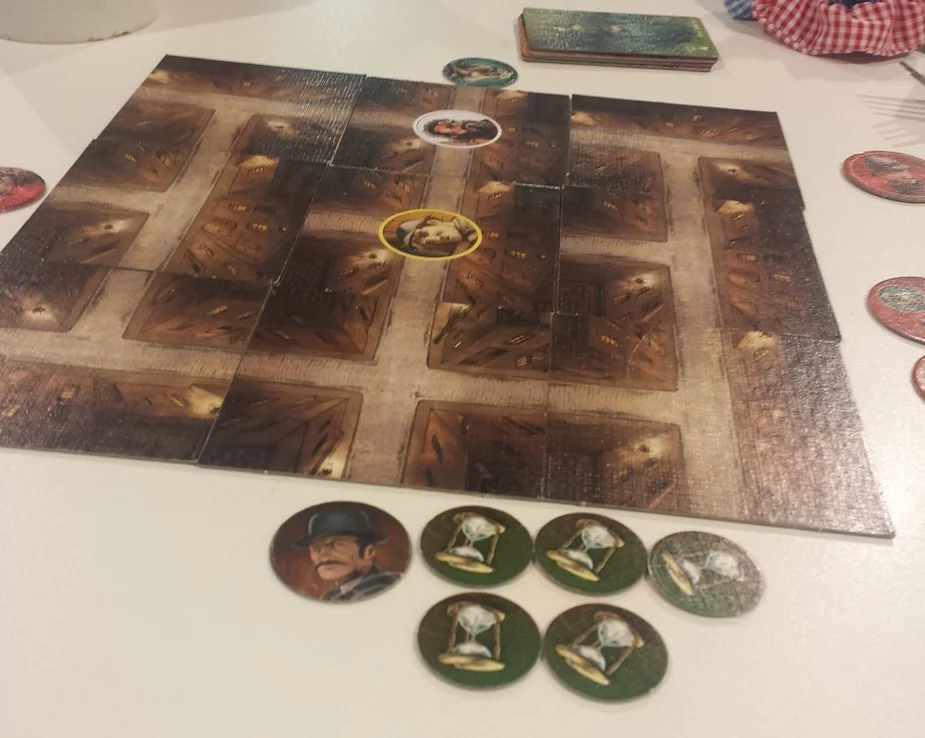
Mr Jack (Pocket).
Before we look at this one it is worth noting that in the workshop we ended up discussing how problematic this game really is. We wondered why there was the need to link Jack (the ripper) with the fictional Sherlock Holmes? Why use Jack the Ripper at all? The under (and mis-) representation of women in the game is once again crushingly disappointing. The aliases Mr Jack assumes are manly white men in manly poses and two simpering women who seem to have only breasts and prostitution to offer. Not only is the characterisation of the women tiresome but also why aren’t half the characters female? And why is everyone white? Add to that a rule book that speaks solely to men. Extremely frustrating and so easily remedied. I did some research on historical criminals and there is loads of information out there. The images in the library’s flickR account might be a good starting point.
And of course – why on earth would you not have included Irene Adler? She was the only person who Holmes viewed as an intellectual equal – who else could be more likely to give the Inspector, Holmes, Toby and Watson a good run for their money?
“… the best plans of Mr Sherlock Holmes were beaten by a woman’s wit.” A.C. Doyle
If you can’t think of any ideas for your game entry for the Games Jam then please make an Irene Adler expansion for this or a Hound of the Baskervilles version. I’ll buy it!
Inside the tiny box there are 9 squares which form the board (district) which Mr Jack is hiding in. Mr Jack must avoid detection by taking on an alias while The Inspector must discover Mr Jack’s assumed identity before time runs out. The game is for two players. The Inspector moves the character tokens around the edge of the board, looking down the alleys for Mr Jack. Meanwhile, Mr Jack must try to either block or maximise their view to stop the Inspector deducing Mr Jack’s identity. The game is well balanced; neither character has any advantage over the other.
The Inspector is aided by Holmes, Watson and Toby the dog- their sometime accomplice. The use of Toby may please some Holmes purists- I know I saw it as a welcome addition. It’s always nice to see some under used and under explored characters show up. We’ve talked a few times about using the game as an opportunity to explore characters that show up fleetingly in the novel or who you feel are overlooked. Why can’t that character be a dog? – Paul Auster wrote a whole novel from the point of view of the dog!
The design of the alleyways and blocked routes on individual tiles gives the board masses of variance. The seeming imbalance in turn taking which resolves over two turns; the double sided counters from which you select your actions; the hourglass tokens both Mr Jack and the Inspector pursue which form a neat way of keeping track of your turns show care for the details of the game design which are sadly lacking when it comes to the theme. It’s a shame because it is a brilliant and innovative little strategy game.
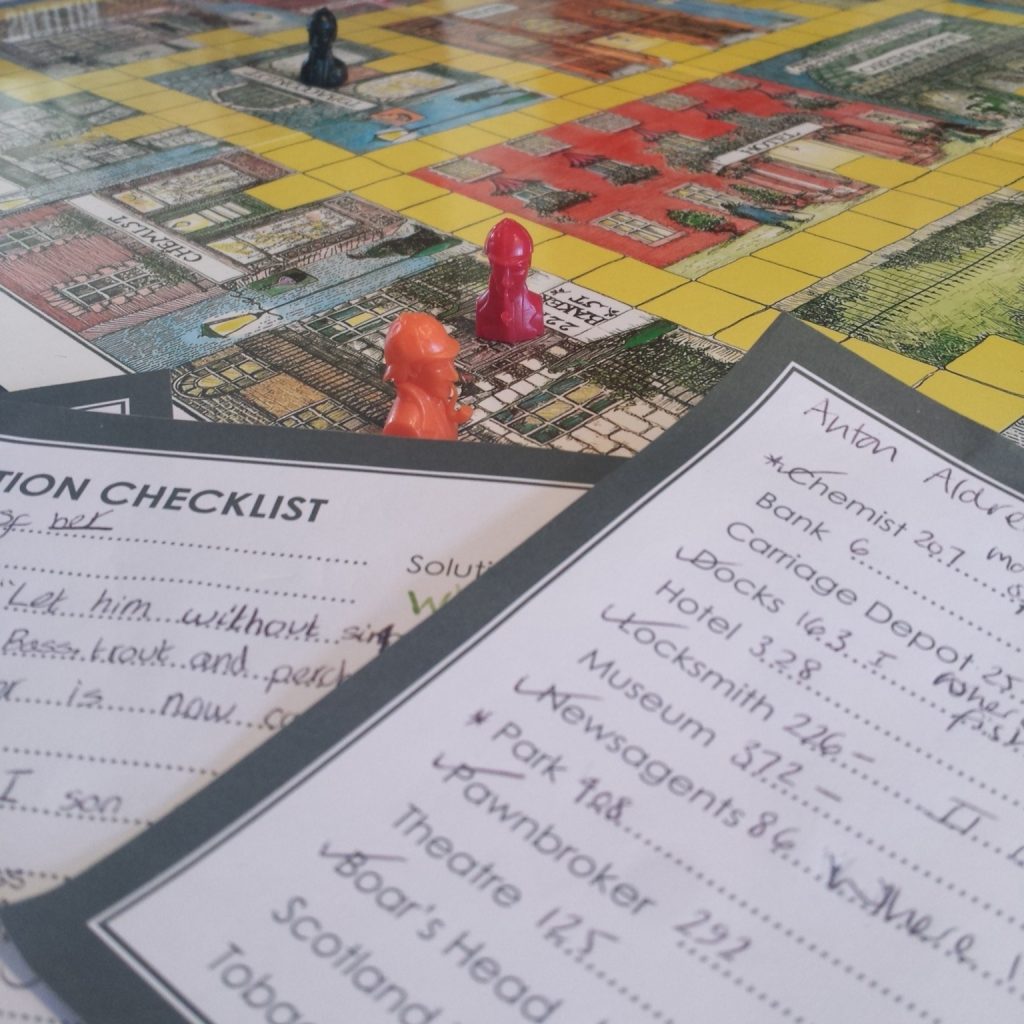
221B Baker Street.
Featuring board gaming’s favourite detective 221B is a great game of sleuthing! Travel around the board finding and deciphering clues to work out the answers you need. Each mystery varies slightly in what you are required to find out – it could be motive, weapon, victim’s identity, the murderer, how or where the crime was committed. You read the mystery and then set off on your mission to solve the crime. Once you think you know you head over to Scotland Yard to tell them what you have found. If you are correct the game ends, if not, you keep your suspicions to yourself and the other detectives keep on sleuthing.
Cluedo in style you move around the board and when you enter a location you look in the book to see if there is a clue. But, it’s harder than Cluedo because there are various levels of clues some in two or three parts some more cryptic than others. In design it is a little like the choose your own adventures that we looked at in session 1 as each mystery has its own set of clues to find and solve. So each game is like a story in itself. This kind of game must have taken a great deal of planning but it’s worth it as it is such good fun to play.
Questions for you to peruse!
How important is the artwork here?
How important will artwork be in your game?
What is a programming mechanic?
What is asymmetry in games?
Does your game need a board? What alternatives could you use?
What components do you like? Is touch important to you? In your game?
How do you feel about expansions – is it something your game could accommodate in the future? Is it something you want it to accommodate or would you rather it stood alone?
Can you use sound or silence in your game?
Could you use familiar games to help hook your audience? Which games would you like to use? Which ones do you think would appeal to your audience?
Think again about your audience – how dark do you want to go?!
Next week we will be looking at Rule Breakers – games that are a bit unusual and don’t fit our usual expectations. You can book onto the workshop here.
